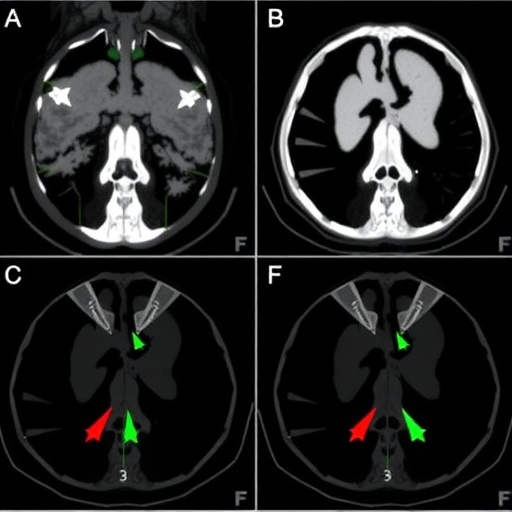
Recent advances in molecular biology have opened exciting avenues for understanding the complex mechanisms of reproductive health, particularly through the lens of microRNAs (miRNAs). These small, non-coding RNA molecules have garnered attention for their regulatory properties, functioning as key players in gene expression and cellular processes such as apoptosis. A groundbreaking study conducted by Musavi and colleagues sheds light on the role of miRNAs in the apoptosis of reproductive systems and their potential implications for infertility. This exploration not only deepens our understanding of reproductive biology but also paves the way for innovative therapeutic strategies to combat infertility.
MicroRNAs are approximately 22 nucleotides long and are known to regulate gene expression at the post-transcriptional level. By binding to complementary sequences in target messenger RNA (mRNA), they inhibit translation or promote mRNA degradation. This intricate regulatory network is crucial in various physiological processes, including development, differentiation, and apoptosis. In the reproductive system, miRNAs play a vital role in maintaining homeostasis, and their dysregulation can lead to significant consequences, such as infertility.
The study by Musavi et al. delves into the specific functions that miRNAs serve in the apoptosis of reproductive cells. Apoptosis, or programmed cell death, is a critical process that ensures the removal of damaged or unwanted cells in an organism, thereby maintaining cellular integrity. In the context of the reproductive system, appropriate apoptosis is necessary for optimal function, whether it be during gametogenesis or the regulation of ovarian and testicular function. Misregulation of this process can result in compromised reproductive health and contribute to infertility.
Among the various miRNAs explored in the study, certain miRNAs were identified as predominantly modulating apoptosis in germ cells and somatic cells of the testes and ovaries. These selected miRNAs regulate survival factors and apoptotic pathways crucial for fertility. By comprehensively assessing their effects, the study consolidates the understanding that these tiny molecules are not merely bystanders but act as orchestrators of reproductive health.
Furthermore, the research emphasizes that the expression of miRNAs can be influenced by hormonal changes, environmental factors, and pathological states. For instance, conditions such as polycystic ovary syndrome (PCOS) demonstrate altered miRNA profiles, which may contribute to the apoptosis of ovarian cells, thereby leading to the characteristic symptoms of this condition. Understanding these relationships highlights the potential for developing targeted interventions aimed at correcting miRNA dysregulation.
Innovative therapeutic approaches are also discussed, focusing on miRNA mimetics and inhibitors that can either bolster or suppress the activity of specific miRNAs implicated in reproductive cell apoptosis. Such strategies could represent a novel means to address infertility, as these treatments could restore normal apoptosis pathways. For instance, in cases where increased cell survival is desirable, delivering miRNA mimetics may enhance the viability of gametes or embryos, improving fertility outcomes.
Moreover, the implications of the research extend beyond gender-specific reproductive health, as it can enlighten our understanding of disorders affecting both male and female fertility. The regulatory mechanisms highlighted in the study underscore the importance of a balanced miRNA landscape, where both apoptosis and proliferation are finely tuned. The duality of miRNAs as both promoters and inhibitors of apoptosis illustrates their profound impact on cellular fate decisions.
The implications of this research are far-reaching, suggesting that a deeper understanding of miRNA functions could lead physicians to explore personalized medicine approaches in reproductive health. By analyzing the miRNA profiles of patients, tailored treatments could be designed, optimizing the likelihood of successful conception through non-invasive or minimally invasive methods.
As fertility issues continue to rise globally, attributing factors to lifestyle changes, environmental toxins, and advanced maternal age, research into miRNA-mediated pathways provides a beacon of hope. By unraveling the intricate roles of these small yet mighty molecules, scientists are inching closer to deciphering the biological puzzles that have long troubled reproductive medicine.
In summary, the comprehensive findings presented by Musavi et al. mark a significant advancement in reproductive health research. Their elucidation of the regulatory functions of miRNAs in apoptosis not only deepens our biological understanding but also identifies potential pathways for therapeutic intervention. Such innovations could revolutionize the treatment of infertility, offering new hope to countless individuals and couples striving to conceive.
As the scientific community continues to explore these avenues, the quest for answers regarding infertility stands boldly on the horizon, imbued with the promise of molecular biology’s future. The work of Musavi and colleagues serves as a cornerstone, laying the foundation for further research into miRNAs, apoptosis, and their intertwined roles in reproductive health.
Through continued exploration of the genetic and molecular underpinnings of reproductive biology, we find ourselves at the cusp of transformative therapeutic approaches that may redefine fertility treatments in profound ways. Although much work remains to be done, the possibilities for enhancing reproductive health through sophisticated genetic interventions are more tangible than ever, thanks to the efforts of researchers delving into the microcosm of miRNAs.
In conclusion, as we stand at this pivotal junction of molecular biology and reproductive health, the implications of further studying miRNAs and their regulatory networks will undoubtedly shape the landscape of infertility treatment in the years to come, illuminating paths of discovery that extend into the vast realms of reproductive science.
Subject of Research: Regulatory Functions of MicroRNAs in Reproductive System Apoptosis and Implications for Infertility.
Article Title: Unraveling the Regulatory Function of MicroRNAs in Reproductive System Apoptosis and Their Implications for Infertility.
Article References: Musavi, H., Ezzati, M., Hoseinnia, S. et al. Unraveling the Regulatory Function of MicroRNAs in Reproductive System Apoptosis and Their Implications for Infertility. Reprod. Sci. 32, 2515–2527 (2025). https://doi.org/10.1007/s43032-025-01897-5
Image Credits: AI Generated
DOI: https://doi.org/10.1007/s43032-025-01897-5
Keywords: MicroRNAs, Apoptosis, Reproductive Health, Infertility, Gene Regulation, Therapeutics.
Tags: dysregulation of microRNAs and infertilitygene expression and reproductive biologyimplications of microRNAs in reproductive systemsinfertility and microRNA regulationmechanisms of reproductive apoptosismicroRNAs in reproductive healthmiRNAs and cellular processesmolecular biology and infertilitynon-coding RNA and fertilitypost-transcriptional regulation in reproductionrole of microRNAs in apoptosistherapeutic strategies for infertility




